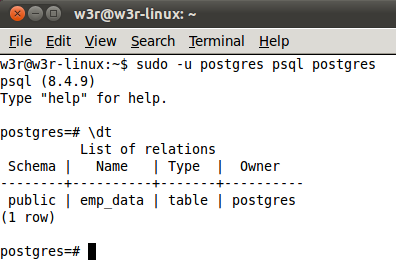
Defaults to the value of the PGPORT environment variable or, if not set, to the port specified at compile time, usually 5432. Specifies the TCP port or the local Unix-domain socket file extension on which the server is listening for connections. nĭo not use Readline for line editing and do not use the command history (see the section called “Command-Line Editing” below). Write all query output into file filename, in addition to the normal output destination. When this option is used, psql will connect to the database postgres, unless a different database is named on the command line (option -d or non-option argument, possibly via a service entry, but not via an environment variable). This is similar to the meta-command \list. Other non-connection options are ignored.

This is equivalent to \pset format html or the \H command. If the value begins with a slash, it is used as the directory for the Unix-domain socket. Specifies the host name of the machine on which the server is running. This is equivalent to \pset fieldsep or \f. Use separator as the field separator for unaligned output. On the other hand, the variant using the shell's input redirection is (in theory) guaranteed to yield exactly the same output you would have received had you entered everything by hand. There is also a slight chance that using this option will reduce the start-up overhead. In general, both will do what you expect, but using -f enables some nice features such as error messages with line numbers. Using this option is subtly different from writing psql < filename. Note however that Readline is not used in this case (much as if -n had been specified). This can be used to intersperse interactive input with input from files. If filename is - (hyphen), then standard input is read until an EOF indication or \q meta-command. Except for that, this option is largely equivalent to the meta-command \i. When either -c or -f is specified, psql does not read commands from standard input instead it terminates after processing all the -c and -f options in sequence. This option can be repeated and combined in any order with the -c option. Read commands from the file filename, rather than standard input. This is equivalent to setting the variable ECHO_HIDDEN to on. You can use this to study psql's internal operations. EĮcho the actual queries generated by \d and other backslash commands. This is equivalent to setting the variable ECHO to queries. eĬopy all SQL commands sent to the server to standard output as well. If so, connection string parameters will override any conflicting command line options. This is equivalent to specifying dbname as the first non-option argument on the command line. Specifies the name of the database to connect to. Switches to CSV (Comma-Separated Values) output mode.

If having several commands executed in one transaction is not desired, use repeated -c commands or feed multiple commands to psql's standard input, either using echo as illustrated above, or via a shell here-document, for example: (See Section 55.2.2.1 for more details about how the server handles multi-query strings.) Because of this, the server executes it as a single transaction even if the string contains multiple SQL commands, unless there are explicit BEGIN/ COMMIT commands included in the string to divide it into multiple transactions. To achieve that, you could use repeated -c options or pipe the string into psql, for example:Įach SQL command string passed to -c is sent to the server as a single request. Thus you cannot mix SQL and psql meta-commands within a -c option. When either -c or -f is specified, psql does not read commands from standard input instead it terminates after processing all the -c and -f options in sequence.Ĭommand must be either a command string that is completely parsable by the server (i.e., it contains no psql-specific features), or a single backslash command. This option can be repeated and combined in any order with the -f option. Specifies that psql is to execute the given command string, command. This is equivalent to setting the variable ECHO to errors. Print failed SQL commands to standard error output. (The default output mode is aligned.) This is equivalent to \pset format unaligned. (This does not apply to lines read interactively.) This is equivalent to setting the variable ECHO to all. Print all nonempty input lines to standard output as they are read.


 0 kommentar(er)
0 kommentar(er)
